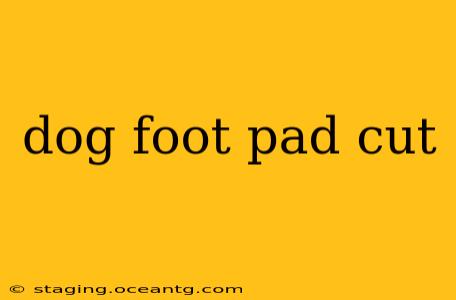A cut on your dog's paw pad can be a painful and distressing experience for both you and your furry friend. Paw pads are tough, but they're also vulnerable to injury. Understanding the causes, treatment, and prevention of these injuries is crucial for responsible pet ownership. This comprehensive guide will address common concerns and provide valuable insights into caring for your dog's paws.
What Causes Cuts on Dog Paw Pads?
Several factors can contribute to cuts on a dog's foot pads. These range from minor scrapes to more serious lacerations.
-
Sharp Objects: Broken glass, sharp rocks, thorns, and even metal fragments can easily puncture or slice a paw pad. This is particularly common in areas with debris or construction sites.
-
Hot Surfaces: Walking on hot asphalt, pavement, or sand can cause severe burns and blisters, which can quickly become infected and lead to cuts.
-
Chemical Burns: Exposure to harsh chemicals, such as antifreeze or fertilizers, can cause chemical burns that damage the paw pads and lead to open wounds.
-
Fight Injuries: Dogs involved in fights may suffer paw pad injuries from bites or scratches.
-
Road Rash: This is often seen in dogs who run across roads, with the asphalt causing abrasions and cuts to the pads.
How to Treat a Cut on a Dog's Paw Pad?
Treating a cut on your dog's paw pad requires careful attention and, in some cases, veterinary intervention.
-
Assess the Injury: Gently examine the paw pad. Determine the severity of the cut – is it superficial, or is it deep and bleeding profusely? Is there any embedded debris?
-
Clean the Wound: Use a clean, damp cloth or cotton swab to gently clean the wound. Avoid using harsh soaps or antiseptic solutions that can irritate the sensitive skin. If there's embedded debris, try to carefully remove it, but if you're struggling, seek professional veterinary help.
-
Apply First Aid: For minor cuts, a thin layer of antibiotic ointment can be applied. You may also use a clean bandage to protect the wound, ensuring it's not too tight.
-
Monitor for Infection: Watch for signs of infection such as swelling, redness, pus, or increased pain. If you notice any of these, contact your veterinarian immediately.
-
When to See a Vet: Deep cuts, excessive bleeding, signs of infection, or any hesitation in your ability to clean and treat the wound warrant immediate veterinary care. Your veterinarian can provide proper wound care, stitches if needed, and pain relief.
How to Prevent Dog Paw Pad Cuts?
Preventing paw pad injuries is significantly easier than treating them. Here are some proactive measures:
-
Regular Paw Inspections: Regularly check your dog's paws for any cuts, abrasions, or foreign objects.
-
Protective Footwear: Consider using dog boots, especially during walks on rough terrain, hot surfaces, or in areas with potential hazards.
-
Avoid Hazardous Areas: Keep your dog away from areas with sharp objects, chemicals, or broken glass.
-
Careful Walks: Walk your dog on grassy areas whenever possible. Avoid walks during the hottest parts of the day, especially on asphalt or pavement.
-
Paw Balm: Applying a paw balm regularly can help keep your dog's paws moisturized and protected from dryness and cracking.
What if my dog is licking their paw pad excessively?
Excessive licking can be a sign of pain, irritation, or an underlying medical condition. It's a crucial indicator that something isn't right. If your dog is excessively licking a paw pad, examine it carefully for any wounds, foreign objects, or signs of inflammation. Persistent licking despite apparent healing can also indicate infection or allergy. Veterinary attention is advisable in this case to identify and address the root cause.
My dog has a deep cut on their paw pad – what should I do?
A deep cut requires immediate veterinary attention. Do not attempt to treat a deep wound at home, as you could risk infection or further injury. Control any bleeding using gentle pressure with a clean cloth and transport your dog to your veterinarian or an emergency animal hospital as soon as possible.
How long does it take for a dog's paw pad cut to heal?
The healing time depends entirely on the severity of the cut. Minor scrapes might heal within a few days, while deeper cuts can take several weeks, even requiring stitches for proper healing. Always follow your vet's instructions for aftercare.
Are there any home remedies for dog paw pad cuts?
While some minor cuts might be treated with antibiotic ointment and a bandage at home, it's always best to consult your veterinarian before using any home remedies. They can provide professional advice tailored to your dog's specific injury. Improper treatment can delay healing or lead to complications.
By understanding the causes, implementing preventative measures, and knowing when to seek professional help, you can ensure your dog's paws stay healthy and happy. Remember, early intervention is key to preventing serious complications.
